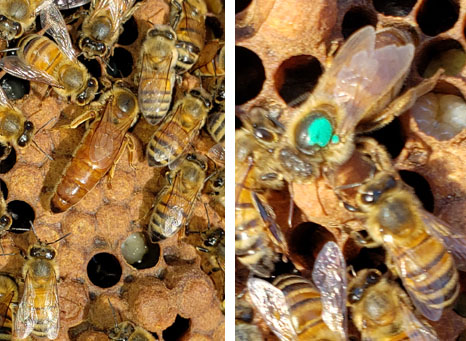
Musings on an Early Season Peek in the Bee Yard
Spring has sprung here in Central Arkansas, and the honey bees are ready for it. The recent weather has been a bit unpredictable, as it always is for us this time of year. The bees have enjoyed several periods of beautiful flying weather, but also had to endure some cold wet spells. This time of year can be very critical for our bees' survival.
The importance of cleansing flights for bees
When the late winter days are warm and bright, our bees come out for brief cleansing flights. This is good for them, since they have no indoor plumbing. Any opportunity to void their hindgut outside must come as a welcome relief, after clustering together for so many long cold winter nights. Also, these periodic bathroom breaks may help to limit the spread of nosema disease in the hive, or even the appearance of similar symptoms of dysentery, caused by a poor diet.
"Chilled brood" - what is it?
Warm days also encourage bees to go out and look for early spring flowers. When they fly around a lot, but find little food, they burn a lot of calories in the search without bringing home anything to show for it. Too much of this and they can burn through the last of their winter stores in a hurry. Often the queen will have started producing a small patch of brood by this point. If we are hit with a sudden cold snap, our bees cluster around their queen and brood to keep them all warm and safe. The colder the temperature is, the smaller and tighter the cluster will be. If there are not enough bees to cover all the brood during the coldest nights, they will conserve as much area as they can, but some larvae on the periphery may freeze. Beekeepers refer to this as "chilled brood" and will find these larvae on the landing board later, when it warms up and the workers unceremoniously drag their dead out onto the front porch.
The effect of cold snaps on bees
Another consequence of a sudden extended cold snap is that when bees cluster on their brood, they tend to stay put. They may consume whatever honey is available to them, and will share it, mouth to mouth, throughout the cluster. Individual bees may leave the warmth of the cluster to visit a cell full of honey, fill her crop, and return to the cluster with food to share. But she cannot be gone for long. Being cold blooded, an individual bee can't remain active for long once the temperature away from the cluster is below about 40 degrees. So if temperatures remain low for too long, the cluster will consume all the food they can reach, but will be unable to move onto more. A cluster can easily move up, onto combs with more honey. Also, the cluster can move along the wide frames, consuming honey from one side to the other. However, it can be difficult for a cluster to move sideways, to the next frame, during cold weather. The entire mass of bees must move with their queen around the edges of the frames, or over the top bars. Also, if there is brood in a comb, they may be reluctant to abandon it and move away.
Why some colonies die despite ample food
Sometimes a beekeeper will discover the remains of a colony apparently dead of starvation, just a few inches from ample food! The last few bees area dead, with their heads in cells, as if they are looking for food. Technically, these bees did not starve, but rather froze because they did not have enough food to generate sufficient heat to keep going. If this happens, there is little a beekeeper can do except clean up and carry on. If there is food in the hive (stored honey or pollen), those frames should be placed into another hive that can use them, or stored in a freezer for later use, to protect them from the ravenous small hive beetles or wax moths.
My personal hives
I was lucky enough to get out into the bee yard over the weekend and had a great time going through hives and evaluating them. I found a couple of colonies had gone queenless sometime during the winter. Because they still had plenty of bees, I was able to give them some brood and hope that they will be able to rear another queen before it's too late. Because there were no signs of significant laying workers, and still populous, I surmised that these two colonies had not been queenless for too long. It's anyone's guess as to why there was no queen.
Can honey bees raise a new queen?
The answer is... usually, yes! Trust that the bees know what to do in most cases. In the absence of a queen, they have an urge to raise a new one. If we provide them with suitable eggs or larvae, they will instinctively choose one or more to turn into a queen. All a beekeeper needs to do is give a queenless colony a frame with eggs or young larvae. If the larvae are too old, they will not make good queens. The red arrow in the photo below (left) shows a larva that is just right. It's about the same size as an egg, and it's floating gently in a pool of royal jelly. The colony should have access to plenty of good food, too (protein-rich pollen and honey or nectar), so they have the resources to raise queens. If we look in that hive again in a few days, we should see queen cells being drawn out right from the existing worker cells.
Is it too early to raise queens?
A queen bee will develop in 16 days, and be ready for her mating flights in a few days later. There should be a good number of mature drones on the wing at that point for her to choose from. It will take drones a couple of weeks to become reproductively mature after they emerge. Therefore, once you see adult drones in your hives, you can be confident that when your new queens are ready to mate, there will be mature drones around for her to find.
There were plenty of big hefty drones throughout the hives I inspected (below, right). You can recognize them by their large bodies and bulging eyes. You will never see these guys on flowers in your garden. When they are not flying around looking for a lonely queen, they prefer to lounge around in the hive, being fed by their sisters. What a life!
Spring and adult drones
The appearance of adult drones also announces the beginning of the spring swarm season. Honey bees are protandrous. This means that they will produce new drones in advance of producing new queens, the female reproductives. This is to ensure that when those queens are ready to mate, there will be plenty of opportunities for them. If we try to initiate queen rearing too early in our hives, the queens may not be able to find any drones, or maybe too few to be properly mated. Again, trust the bees to recognize that spring is here, and wait until you see drones to make your splits. About 4 weeks or so after drones first emerge, we typically begin to see the first swarms. So keep an eye out for swarm cells now!
Queen cup - not quite a chalice
When a queen bee is feeling crowded, and begins running out of places to lay eggs, she will seek out a queen cup. This is a shallow, empty, vertical cell, often found along the bottom edges of the combs (below, left). Queen cups are also often constructed anywhere the bees repair damaged comb, and there are exposed edges on a lower surface (below, right). As long as these cells are empty, they are called queen cups. As soon as a queen deposits an egg in one of these, it becomes a queen cell, and will be provisioned with ample royal jelly as soon as the egg hatches into a larva. The worker bees recognize any larva in this vertical orientation to be one that a queen has chosen to be one of her potential replacements. Beekeepers can use this instinctive trait to induce a colony to rear queens. If we place larvae into a queenless hive in shallow cells facing down, the bees will almost always try to rear as many into queens as possible.
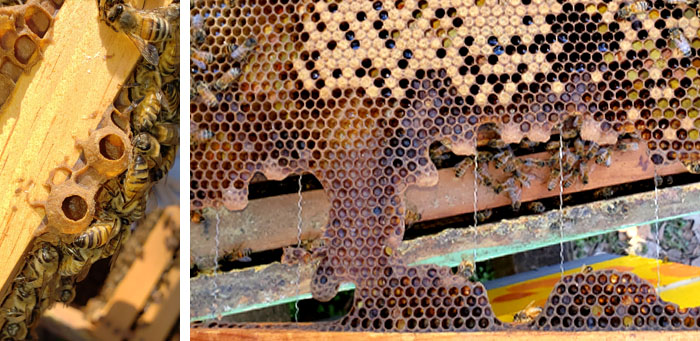
| (Left) This combs shows freshly deposited honey bee eggs in the cells. The red arrow indicates a larva that would be just right to turn into a new queen bee. (Right) A male bee, called a drone, wanders around on the comb among his sisters. The presence of drones indicates that queen rearing can begin. Their appearance also suggests that the spring swarm season will soon be here. |
Finding a queen - the struggle is real
Many beekeepers have trouble finding their queens. And it's no wonder, with thousands of bees in the hive, all moving around, and often covering the queen, who is also often hiding from the light. The longer a hive is opened and disturbed, the harder it can be to find a shy queen. I spotted this large beaut (below) trying to run around the edge of the comb and out of sight. Once you begin to recognize them, queens become easier to spot. I carefully picked her up to mark, but my paint job turned out a little sloppy time.
International Queen Marking Color Code
| Color | For Year Ending In |
|---|---|
| White or Gray | 1 or 6 |
| Yellow | 2 or 7 |
| Red | 3 or 8 |
| Green | 4 or 9 |
| Blue | 5 or 0 |
Coloring a queen bee
Beekeepers actually use an international standard set of colors that indicate the age of the queen. As the chart above indicates, we use the last digit in the year to select her color, which indicates her age. This queen was marked in green, but I suspect she was probably born last summer, and should have been marked in red. However, I had a green pen in my pocket, so she gets to lie about her age! Regardless fo the color she wears, This tiny dot will make her highness much more obvious next time I open her hive.
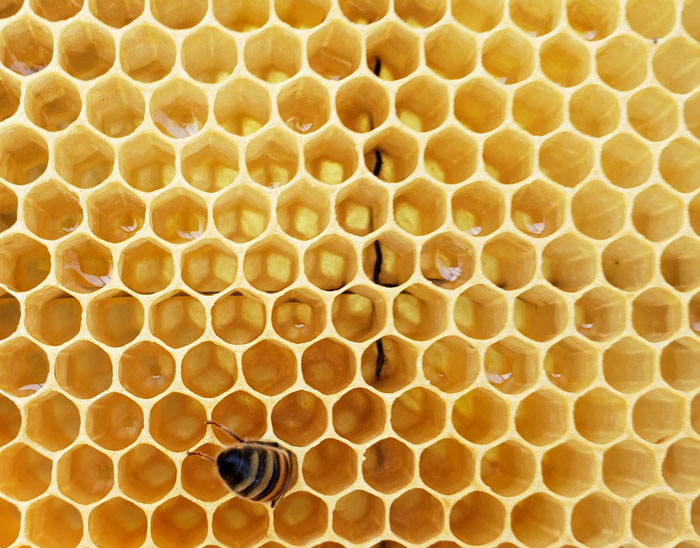
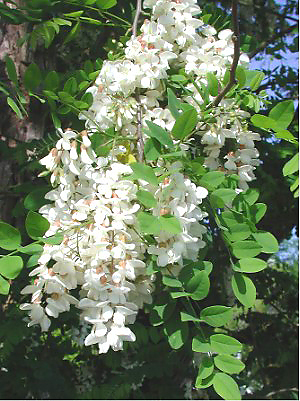
Elsewhere in the hives, industrious workers were already beginning to fill the honeycomb cells with fresh nectar. It's still very thin and watery at this point, so we must be careful to hold the frames upright, and not let the bees' hard work pour out onto the ground. Most of the nectar that the bees collect this early will be consumed to fuel their early brood rearing and comb production activities. However, some years when temperature and weather conditions are just right, we can get quite a good crop of early season honey. Honey from this time of year varies with plant species, but is typically very light in color and has a mild, sweet, floral flavor. As we progress into summer, honey tends to be darker and have more robust earthy and savory overtones. There is no such thing as "honey" flavor... there are as many variations in honey color, flavor and aroma as there are in wines.
What plant produces "water white" honey?
The black locust tree (Robina pseudoacacia) is an early blooming plant that produces a honey, described as "water white" by honey judges. These beautiful, thorny trees are common in the northwest part of our state. They produce copious amounts of nectar in large, fragrant hanging clusters of white flowers. However, their their blooms often coincide with periods of heavy spring rains, which tend to wash the nectar away and prevent the bees from venturing out to collect it. But once in a while, when mother nature cooperates, and beekeepers are on the ball, these trees can provide the raw material for a rare treat.
What's up with those red bee abdomens?
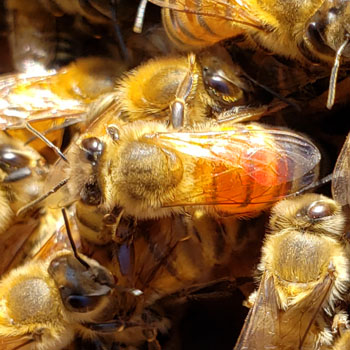
When the sunlight shone through them, they appeared to have bright red abdomens (this photo doesn't do her justice). Their honey crops, where they transport their liquid load when foraging for nectar, was filled with something very colorful. No flower in nature has such vivid red nectar for the bees to collect. What could it be? I suspect that somewhere in my neighborhood, a good-hearted nature lover has been generously filling a hummingbird feeder for the return of migrating hummingbirds to stop and have a drink. Hummingbirds are attracted to bright red flowers, and many of these feeders are also red. While coloring the sugar syrup red is traditional, it's really discouraged now, as an unnecessary additive.
All in all, I was pleased with how well my bee colonies had overwintered. A couple of them needed a little gentle help, but mostly they did well on their own. And with the weather warming and spring forage becoming more abundant, there is no reason they can't all have a productive year. Throughout the bee yard, workers are feeding their queens a rich diet of royal jelly, from the abundant pollen they are collecting. These queens can lay more than 1000 eggs each day, which will take about 3 weeks to grow into new worker bees. The one below is just emerging from her pupal cell, and is about to begin her short but busy career in the honey industry. Welcome to the world, little lady!
